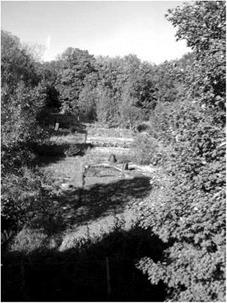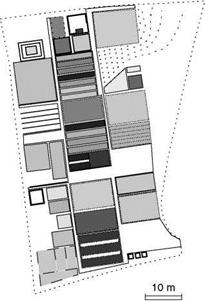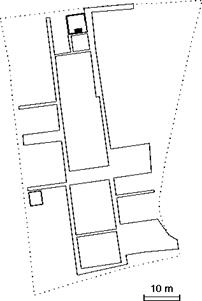Andre Viljoen and Katrin Bohn
Figure 19.1 (photo of Moulsecoomb) shows an allotment site in Moulsecoomb, a suburb on the edge of Brighton, on the south coast of England. The site, on a south facing slope is small, having nine standard allotment plots, with an area of 250 m2 each, and an overall site area of about 3200 m2.
It is occupied by the Moulsecoomb Forest Garden and Wildlife Project, which serves a number of different groups, including community garden volunteers, unemployed people and young children. The project is self-regulated and has financial support from a number of local organisations (Carter, 2001). This diverse group of users, with different backgrounds, desires and interests, has created a
usage pattern by which a network of public spaces has been overlaid onto regular urban agriculture plots. This characteristic of ‘overlay’ is one of the principal features of Continuous Productive Urban Landscapes and the small size of this site shows overlay at its most intimate scale.
Figure 19.2 shows the original arrangement of allotments at Moulsecoomb, nine equal rectangular plots with narrow footpaths inbetween. Figures 19.3 and 19.4 demonstrate how occupation by people has changed the original arrangement of plots, showing how paths have been extended to encompass parts of the planting beds and provide areas for people to use in other ways. Contemplative, recreational, and
|
|
|
|
Figure 19.1 Moulsecoomb allotments, Brighton 2002.
Figure 19.2 Moulsecoomb allotments Brighton 2002: plots as rented out to occupants.
private spaces can be found within these extensions to the original footpaths. The whole arrangement can be read as a network (see Figure 19.3) superimposed onto the original layout (see Figure 19.2) resulting in the final mix of occupations, with spaces for growing and living (see Figure 19.4).
Within the overlay of public space, occupants have constructed an enclosure for shelter, and lawns sloping towards the south and the sun, as places for sitting or lying, and a forest garden that offers a retreat. The space fosters social interaction within the local community and between cultivators and other occupants. It can be characterised as a
gregarious space, one where social and productive landscapes coincide.
Moulsecoomb represents a micro model for a larger urban intention. It provides a number of clues for how, at the urban scale, Continuous Productive Urban Landscapes may be structured. It demonstrates how a matrix of circulation and occupational spaces can articulate and contain fields for growing. At an urban scale, paths in Moulsecoomb can be imagined as primary pedestrian and cycle ways, planting beds can be thought of as market garden sites, fields in the city. By examing the Moulsecoomb site as found and simultaneously imagining the
|
|
|
|
Figure 19.3 Moulsecoomb allotments Brighton 2002: network of paths and shared space introduced by the occupants. Figure 19.4 Moulsecoomb allotments Brighton 2002: occupation, showing the overlay of paths, shared space and plots for food growing.
allotments as city blocks or large fields of urban agriculture, a pattern of urban development can be imagined, in which the principle of overlay and Continuous Productive Urban Landscapes has been applied at a number of different scales.
In addition to seeing how occupation modifies a strict municipal geometry by providing space for social life, the site shows productive urban landscapes as a visual resource and marker of seasonal change.
From an adjacent commuter bridge at a railway station, the Moulsecoomb site offers a view to pedestrians. This view is important to our understanding of another aspect of urban agriculture. It demonstrates how agricultural fields provide urban dwellers with a connection to horticulture, to agriculture and by extension to an understanding of human interaction with nature. This connection, which is visual, answers a powerful human desire for contact with the countryside, or at least a need for contact with an idea of nature and countryside. The significance of this desire is demonstrated by the popularity of suburban dwellings on the rural fringe and the popularity, for those who can afford it, of a weekend cottage. For a city dweller, having regular contact with urban agriculture is like having a house in the countryside.
Imagine the qualities brought to a city if the conditions found in Moulsecoomb’s productive urban landscape were repeated across a city, to become a Continuous Productive Urban Landscape.
 |
|
|

REFERENCE
Carter, W. (2001). Seedy Business – tales from an allotment shed. Moulsecoomb Forest Garden and Wildlife Project.







